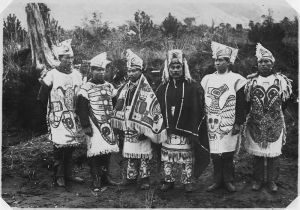
Recent strides in DNA research are beginning to fill many of the gaps left in multidisciplinary scientific attempts to reveal and understand human prehistory. Some of these studies have provided clues to the dispersal of ancient humans across the globe going back tens of thousands of years.
Now, University of Illinois anthropology professor Ripan Malhi is analyzing DNA to tell the story of how and when humans first arrived in the Americas, and then what happened to them afterwards. Through study sites in British Columbia, California, Guatemala, Mexico and Illinois, he hopes to help find long-sought answers to the big, debated questions addressing the who, when, and where of the first Americans and the dynamics of their spread and activity across the Americas.
“The best opportunity to infer the evolutionary history of Native Americans and to assess the effects of European colonization is to analyze genomes of ancient Native Americans and those of their living descendants,” Malhi said. “I think what makes my lab unique is that we focus not only on the initial peopling of the Americas but also what happened after the initial peopling. How did these groups move to new environments and adapt to their local settings over 15,000 years?” Researchers may draw the wrong conclusions about human history when looking only at artifacts and language, he maintains.
Malhi, an affiliate of the Institute for Genomic Biology at Illinois, is taking a collaborative approach to his quest. He works with present-day Native Americans to study their genetic history. By recently cooperating with members of the Tsimshian Nation on the northwest coast of British Columbia, for example, he found a direct ancestral link between ancient human remains in the Prince Rupert Island area and the native peoples living in that region today. That study examined changes in the mitochondrial genome over time. (Mitochondria are structures within eukaryotic cells that convert chemical energy from food into a form that cells can use. Abbreviated as mtDNA, they are inherited by children solely from the mother.)
Other studies from Malhi’s lab analyze changes in the Y chromosome or the protein-coding regions of the genome. DNA in the Y chromosome is passed from father to son.
“What’s interesting about the northwest coast and California is that these communities were complex hunter-gatherer societies,” adds Malhi, “whereas in Mexico and Guatemala, it’s more communities that transitioned to farming and then experienced the effects of European colonization.”
Malhi is reporting some of his findings before the Royal Society in London on Nov. 18 and 19.
_______________________________________________________________________________________________________________________
Anthropology professor Ripan Malhi works with Native Americans to collect and analyze their DNA and that of their ancestors. Credit: L. Brian Stauffer
_______________________
Cover Photo, Top Left: Metlakatla people of British Columbia in ceremonial attire. Wikimedia Commons
_______________________________________________________________________________________________________________________
Read about the most fascinating discoveries with a premium subscription to Popular Archaeology Magazine. Find out what Popular Archaeology Magazine is all about. AND MORE:
 Popular Archaeology’s annual Discovery edition is a selection of the best stories published in Popular Archaeology Magazine in past issues, with an emphasis on some of the most significant, groundbreaking, or fascinating discoveries in the fields of archaeology and paleoanthropology and related fields. At least some of the articles have been updated or revised specifically for the Discovery edition. We can confidently say that there is no other single issue of an archaeology-related magazine, paper print or online, that contains as much major feature article content as this one. The latest issue, volume 2, has just been released. Go to the Discovery edition page for more information.
Popular Archaeology’s annual Discovery edition is a selection of the best stories published in Popular Archaeology Magazine in past issues, with an emphasis on some of the most significant, groundbreaking, or fascinating discoveries in the fields of archaeology and paleoanthropology and related fields. At least some of the articles have been updated or revised specifically for the Discovery edition. We can confidently say that there is no other single issue of an archaeology-related magazine, paper print or online, that contains as much major feature article content as this one. The latest issue, volume 2, has just been released. Go to the Discovery edition page for more information.
Subscription Price: A very affordable $5.75 for those who are not already premium subscribers of Popular Archaeology Magazine (It is FREE for premium subscribers to Popular Archaeology). Premium subscribers should email [email protected] and request the special coupon code. Or, for the e-Book version, it can be purchased for only $3.99 at Amazon.com.





